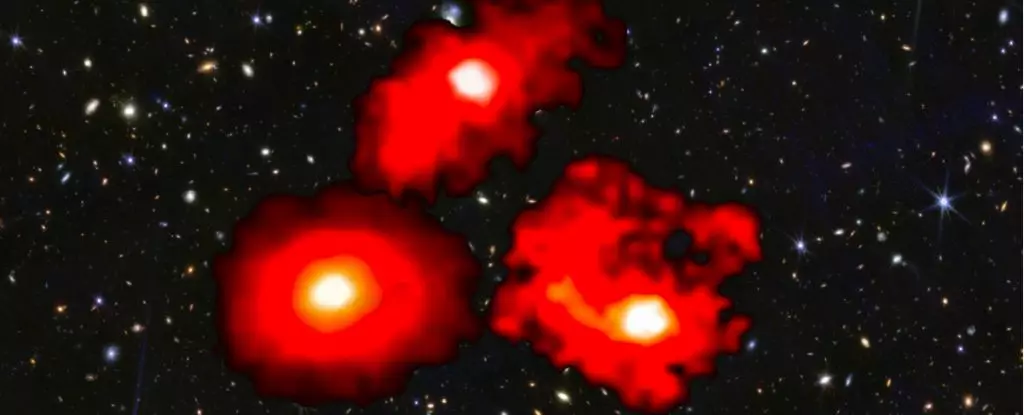In the vast tapestry of the cosmos, the early Universe was a realm filled with uncertainty and dramatic transformations. Among these transformations, a bewildering discovery has surfaced: astronomers have identified three extraordinarily large galaxies, dubbed ‘red monsters,’ which appear to challenge our established understanding of galaxy formation during the nascent epochs following the Big Bang. This revelation is not merely an incremental step in cosmic research but a significant leap that compels scientists to reassess fundamental theories about the growth and maturity of galaxies long before they should logically exist.
The existence of these so-called red monsters poses profound questions about the early cosmos. As noted by astronomer Ivo Labbé from Swinburne University of Technology, the scenario resembles finding a toddler weighing about 100 kilograms—it’s a situation that defies all expectations and norms. The James Webb Space Telescope (JWST) has propelled our gaze deeper into the Universe, unveiling celestial entities that question the linear narrative of the cosmic timeline. Within the first billion years after the Big Bang, galaxies were not expected to reach the sizes comparable to our Milky Way, leading to a reconsideration of the galaxy formation timeline.
Traditional cosmological models suggest that galaxies coalesced from regions of dark matter, gradually attracting baryonic matter—the building blocks for stars and galaxies. However, the detection of these unexpectedly massive galaxies indicates that the convergence of matter and energy may have happened at a vastly accelerated pace than previously understood.
With the deployment of JWST, researchers have gained access to unprecedented data that illuminates the Cosmic Dawn. The telescope’s ability to capture the infrared light emitted from distant cosmic phenomena offers insights that were previously unattainable. The stretching of light waves from receding objects can obscure our interpretation of their size and brightness, leading to potential miscalculations in the mass of galaxies. Initial thoughts on the existence of these red monsters proposed that their large appearance might simply result from luminous emissions associated with their central black holes.
Nonetheless, a recent study led by astronomer Mengyuan Xiao from the University of Geneva indicates that, in certain instances, these galaxies may be truly massive in nature. The findings suggest that such galaxies are converting baryonic matter into stars at breakneck velocities—rates two to three times higher than what is observed in the more mature galaxies of present epochs. This revelation not only broadens our cosmic perspective but also raises further questions about the mechanisms driving star formation in the early Universe.
While most of the galaxies studied in JWST’s FRESCO program conform to existing models of galaxy evolution, these three anomalies are a cause for concern among astrophysicists. They hint at a level of star formation activity that current models struggle to explain. The prevailing theory states that an explosion of new stars generates significant feedback on their surrounding environment, effectively creating a resistance against further star formation. Hence, the existence of these active red monsters reveals a gap in our understanding of cosmic evolution.
The team’s findings suggest that despite the potential for high levels of feedback, something in the early Universe allowed for an acceleration in star formation. This phenomenon could imply unknown factors or forces at play, further complicating our existing paradigms concerning cosmic growth.
The discovery of ‘red monsters’ marks a pivotal moment for cosmology, as it not only blends intrigue with scientific inquiry but also prompts an urgent reevaluation of our cosmic timelines and theories. Understanding these anomalies may indeed require a blend of theoretical refinement and innovative observational techniques. As astronomers continue to investigate the depths of the Universe using advanced telescopes like JWST, we are likely to uncover numerous other anomalies that may reshape our current models of astrophysics.
The journey into the cosmos teaches us humility in the face of nature’s profound mysteries. The more we explore, the more apparent it becomes that our grasp of the Universe is still maturing. These early revelations remind us that as we seek knowledge, we often confront the boundaries of what we think we know—igniting new directions of inquiry that will guide future generations of scientists and stargazers alike.


Leave a Reply